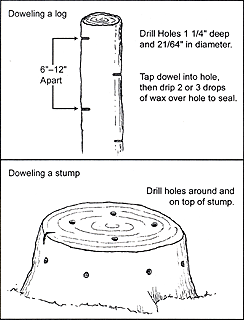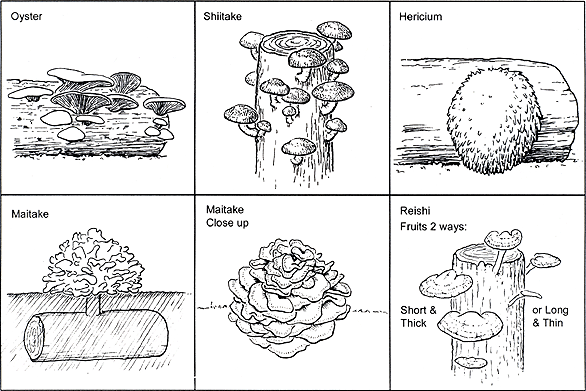Your Cart is Empty
You have no items in your cart. Shop our Mushroom Kits to add a kit to your cart. To place an order over the phone, call Mushroom Adventures at (530) 741-2437 between 8:00 AM and 5:00 PM PST or Contact us online.
530-701-9700
E-mail: Donald@mushroomadventures.com
Mushroom Adventures, 11107 Highway 70, Marysville, CA 95901
Dowels are used to inoculate wood logs or stumps with the mushroom fungus. Use wood that has clean hart wood, which has not been contaminated with any other fungus. This is usually accomplished by using freshly cut live wood, which has been dried shortly after cutting. (By storing the wood dry, wild funguses are prevented from growing into the wood.) Good sizes of wood to use are logs 3 to 8 inches in diameter and about 2 to 4 feet long. (Note: Older, but not rotten wood can be used, but pasteurizing it may be a good idea. Pasteurizing kills any contaminating fungi, which may have begun to grow into the old wood. Pasteurize the wood for 3 to 6 hours at temperatures above 140 degrees. A steel barrel with a couple inches of water inside it sitting on cinder blocks can be used as a cooking chamber. Build a small fire under the barrel to boil the water. Cover the top of the barrel with a piece of plywood.  Be sure if you are using old wood that it is not rotten. Rotten wood will not grow mushrooms.) Soak the logs or leave them in the rain, until they are wet inside, this may take one to two days. Do not remove the bark from the logs. The bark is important it creates a microclimate necessary for the baby mushroom to form. The dowels are 5/16 inch in diameter. When we soak them in water, they swell an additional 1/64 of an inch. If the dowels are to fit correctly into the hole, the hole must be drilled to a diameter of 21/64 of an inch and 1 ¼ inch deep. Space the holes 6 to 12 inch apart. Gently tap into each whole a dowel, until it is flush or below the surface of the bark. (Optional, drip a couple drops of melted candle wax over the dowel to prevent it from drying out.) Use only one mushroom variety per log. When you are done keep the logs wet and moist for 8-12 weeks to give the mycelium time to grow threw the logs. This can easily be accomplished by leaving the logs outdoors in the rain and dew. Mycelium cannot grow in dry or water saturated log. You can stack the logs outside under a tree in the shaded to keep them from drying. Maitake logs, after fully colonized (2-3 months later) should be buried 2 to 3 inches under ground. They prefer to fruit up and out from the soil.
Be sure if you are using old wood that it is not rotten. Rotten wood will not grow mushrooms.) Soak the logs or leave them in the rain, until they are wet inside, this may take one to two days. Do not remove the bark from the logs. The bark is important it creates a microclimate necessary for the baby mushroom to form. The dowels are 5/16 inch in diameter. When we soak them in water, they swell an additional 1/64 of an inch. If the dowels are to fit correctly into the hole, the hole must be drilled to a diameter of 21/64 of an inch and 1 ¼ inch deep. Space the holes 6 to 12 inch apart. Gently tap into each whole a dowel, until it is flush or below the surface of the bark. (Optional, drip a couple drops of melted candle wax over the dowel to prevent it from drying out.) Use only one mushroom variety per log. When you are done keep the logs wet and moist for 8-12 weeks to give the mycelium time to grow threw the logs. This can easily be accomplished by leaving the logs outdoors in the rain and dew. Mycelium cannot grow in dry or water saturated log. You can stack the logs outside under a tree in the shaded to keep them from drying. Maitake logs, after fully colonized (2-3 months later) should be buried 2 to 3 inches under ground. They prefer to fruit up and out from the soil.
In a few days the mushroom mycelium will begin to grow off the dowel and into the wood. It will continue to grow into the wood as long as the wood is moist and, until it colonizes the entire log or stump. Depending on the variety of mushroom, colonization may take 2 to 6 months. The temperature will also effect colonization time. Warm temperatures speed up colonization and cold temperatures slow it down.
Storing your dowels. Your dowels can be stored by refrigerating them. Temperatures of 35 to50 degrees F. are adequate. Dowels can be stored for several weeks and even months. I recommend four to six weeks as a safe period of time. Some varieties of mushrooms store better than others, but to be safe use them as soon as possible.
Fruiting mushroom logs and stumps. Since growing mushrooms on logs and stumps is usually an outdoor operation, the grower is subject to uncontrolled weather conditions to cause the logs to begin to fruit mushrooms. This generally happens when the weather is wet for a few days and the temperature is between 50 to 70 degrees. Rain or heavy morning dew for several days can also cause mushrooms to fruit. Keep a watch on the logs when the weather conditions are favorable. Logs and stumps can produce mushrooms for several years, with breaks during the hottest and coldest times of the year.

Wood to use. Oyster mushrooms will grow on all hard and semi hardwoods listed below. Shiitaki, Maitake, Hericium (Lion’s Mane), and Reishi should be grown on hardwoods only, see table below.
| Hardwood to use | Semi-Hardwood to use | Wood not to use |
| All Oaks, and Tan Oak | Willow | Redwood |
| Madrone | Cottonwood | Cedar |
| Manzanita | Poplar | Fir |
| Most fruit wood | Ash | Pine (conifers) |
| Alder | Others not mentioned | Cypress |
| Maple | Juniper | |
| Bay | |
Eucalyptus |
| Elm | |
Others not mentioned |
| Others not mentioned | |
|